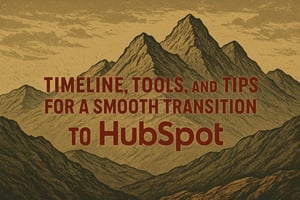Migrating your CRM to HubSpot is not just about moving contacts from Point A to Point B. Done...
The Ultimate Guide to Migrating to HubSpot
Migrating to HubSpot is more than moving your contacts and website pages from one place to another. It is about creating a unified platform where your marketing, sales, and service teams can work together in one system that is easy to use and built to scale with your business.
This guide will walk you through the key steps for a smooth migration, explain the tools and timeline you should expect, and give you a checklist you can follow to protect your data and your SEO. Whether you are moving from Salesforce, WordPress, Zoho, or another CRM or CMS, the process is similar but the planning is everything.
Why Migrate to HubSpot
HubSpot offers an all-in-one platform that combines CRM, marketing automation, CMS, service tools, and analytics. The reasons companies choose to migrate often include:
-
Centralizing data in one system
-
Improving marketing and sales alignment
-
Taking advantage of HubSpot's automation tools
-
Gaining deeper insight through integrated reporting
-
Reducing the number of separate systems and integrations
When done correctly, the migration can also improve site performance, streamline workflows, and eliminate many of the headaches of managing disconnected systems.
Step 1: Plan and Audit Before You Move Anything
The most common mistake in a migration is moving too quickly without a clear plan. A pre-migration audit should include:
-
Exporting your existing CRM and CMS data
-
Cleaning your data to remove duplicates and fix formatting issues
-
Mapping your current fields to HubSpot properties
-
Identifying which assets will be rebuilt, redesigned, or removed
-
Reviewing integrations that will need to be reconnected or replaced
It is also smart to benchmark your current site performance and SEO metrics. This gives you a baseline to compare against after launch.
For a step-by-step breakdown of key dates, essential tools, and insider tips, check out our Timeline, Tools, and Pro Tips for a Smooth Transition to HubSpot.
Step 2: Set Up Your HubSpot Environment
Before importing data or rebuilding your website, configure your HubSpot account:
-
Create user accounts, teams, and permissions
-
Set up custom properties to match your existing CRM fields
-
Build your deal and ticket pipelines
-
Connect your domain and verify email sending
-
Enable essential tools like forms, chat, and tracking codes
This step ensures the system is ready to accept your data and assets without delay.
Step 3: Migrate Data and Content
Data migration includes contacts, companies, deals, tickets, and in some cases custom objects. For CMS migrations, you will also be moving blog posts, landing pages, media files, and design templates.
You can migrate using HubSpot's built-in import tools for smaller datasets or use specialized tools like Import2 or Data2CRM for more complex needs. For large-scale projects or heavily customized CRMs, HubSpot APIs may be necessary.
Run test imports to confirm your mappings are correct before moving all data.
Step 4: Rebuild Automations and Reports
Workflows, sequences, lead scoring, and dashboards do not migrate automatically. They need to be recreated in HubSpot. This is also a good time to optimize them based on what is working and what is not in your current system.
-
Rebuild email nurture sequences
-
Recreate sales automation workflows
-
Configure lead scoring criteria
-
Set up reports and dashboards that match leadership’s needs
Step 5: Test and Train
Once your data and workflows are in place, test every part of the system:
-
Submit forms to confirm routing and follow-up
-
Check email deliverability
-
Test automation triggers
-
Review page load speeds and mobile responsiveness
After testing, schedule team training sessions so everyone knows how to use the new system from day one.
Step 6: Launch and Monitor
Go live with your HubSpot environment and monitor closely during the first 30 to 60 days:
-
Watch for errors in data syncs or automation triggers
-
Track traffic, rankings, and form submissions
-
Check for 404 errors and fix any missed redirects
-
Use HubSpot’s SEO recommendations to address new issues
HubSpot Migration Timeline
Typical small-to-midsize migrations take 4 to 8 weeks:
| Phase | Timeframe |
|---|---|
| Pre-migration audit | 1–2 weeks |
| HubSpot setup | 1 week |
| Data and content migration | 1–2 weeks |
| Workflow and report rebuild | 1–2 weeks |
| Testing and training | 1 week |
Enterprise migrations or those with complex integrations can take 12 weeks or more.
Common Challenges and How to Avoid Them
-
Poor data hygiene: Clean data before migration to avoid importing problems into the new system.
-
SEO loss: Maintain URL structures where possible and use 301 redirects for any changes.
-
Underestimating automation rebuilds: Plan for time to recreate workflows and sequences.
-
User adoption: Schedule training early to build team confidence.
How Huntscape Operations Partners Can Help
At Huntscape Operations Partners, we specialize in complex HubSpot migrations for B2B companies. Our team combines HubSpot technical expertise with operational experience in sales, marketing, and revenue operations.
We handle the full migration process, from auditing and data cleanup to automation rebuilds and post-launch optimization. Our approach ensures you keep your historical data, maintain your SEO rankings, and launch with a system your teams can use effectively from day one.
If you are planning a HubSpot migration, we can help you avoid common pitfalls, speed up the transition, and start seeing value from HubSpot faster.
Final Thoughts
Migrating to HubSpot is a strategic project that can deliver major benefits if done with the right planning and execution. By following a clear process, using the right tools, and involving experienced partners, you can ensure a smooth transition with minimal disruption to your business.
If you are ready to start your migration, contact Huntscape Operations Partners for a no-obligation consultation. We can help you scope your project, identify potential risks, and map out a plan that works for your business.


